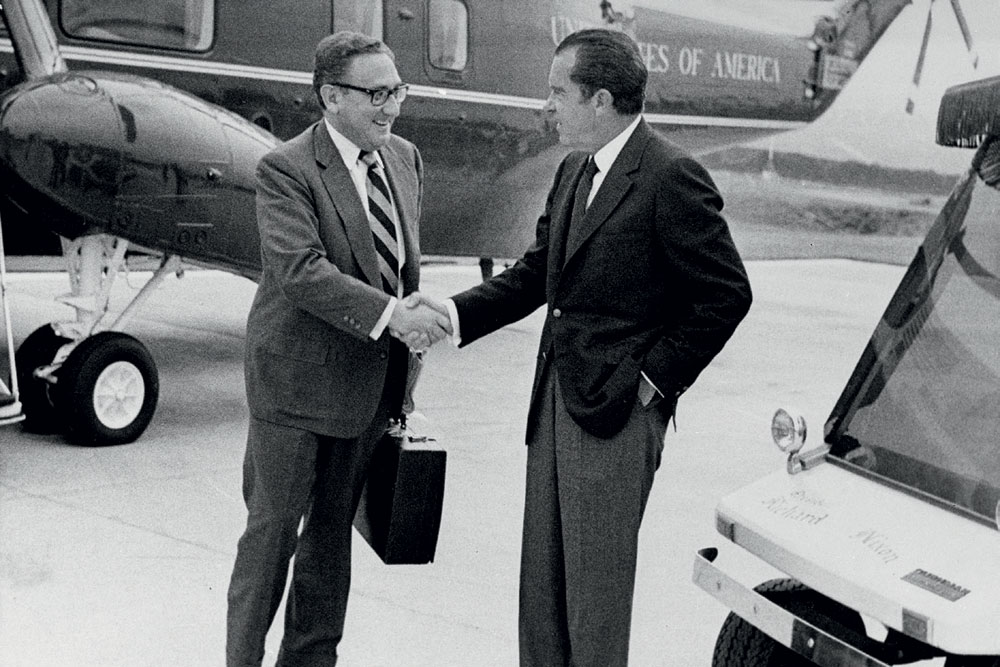Who’s Afraid of Pax Americana?
The shape of the world tomorrow hinges on the strategic choices the US makes today
 Sudeep Paul
Sudeep Paul
 Sudeep Paul
Sudeep Paul
 |
21 Feb, 2020
|
21 Feb, 2020
/wp-content/uploads/2020/02/PaxAmericana1.jpg)
(Illustration: Saurabh Singh)
You aren’t going to like what comes after America.
—Leonard Cohen
IN JOHN LE Carré’s Agent Running in the Field (2019), a veteran spymaster tells a veteran spy: ‘And that was our special relationship with the United States for you. Sucking away merrily on the hind tit of American power. Getting our rocks off. Where are we now? Back of the queue behind the Huns and the Frogs. With a bloody sight less to offer. Total disaster.’ The context is Brexit and the UK’s need for a more special relationship with the US while managing the fallout of the political firestorm in Washington DC.
A decade ago, some analysts had begun arguing that America should get out of Afghanistan and Iraq, scale down in the Middle East, and focus instead on fixing the failing state next door—Mexico. That would save the US lives and resources, contribute tangibly to its security, allow it to prosper again and deal more effectively with China in the long run. With the likes of John Mearsheimer, Andrew Bacevich and Stephen Walt among their ranks, these were formidable scholars and their critique of US foreign policy was not without merit. In fact, it made a lot of sense. Yet, if Washington had pulled out of Iraq and Afghanistan back then, the slaughter would have been bigger. George W Bush’s late troop surge stemmed the bloodbath in Iraq and stabilised the country. Then Barack Obama took the US out in 2011 and Iraq almost ceased to exist, with the Islamic State expanding rapidly to soon threaten Baghdad and the Middle East. Afghanistan, after the drawdown, saw the resurgence of the Taliban in whose hands the country is practically being left today. The proof of American power and the importance of American presence is the story of Afghanistan and Iraq, of a necessary and an unnecessary war, even if we set aside India’s own strategic concerns with the former.
IT ALL BEGAN with Mexico. The Mexican War of 1846-1848 and the Mexican Cession left the US bigger and properly bicoastal. However, America’s birth as a global military-cum-colonial power would have to wait till the 1898 Spanish-American War when Cuba gained its independence and the US came to possess Puerto Rico, the Philippines and Guam. America may have begun as a reluctant global power but quickly came to grasp how its new role and responsibilities meant a new diplomacy of ‘closer and more complex relations with all the other great Powers of the world’, as George Lockhart Rives had immediately understood.
The Spanish-American War had another important consequence. It stretched the US across the Pacific and brought to life naval officer and historian Alfred Thayer Mahan’s The Influence of Sea Power Upon History, 1660-1783 (1890). Mahan’s treatise would be the bible of American sea power and, a century later, notwithstanding their datedness, his analyses would be taken to heart by the rising People’s Republic of China and its navy. While Halford Mackinder had looked at the land and identified the Eurasian Heartland as the determiner of the fates of empires, Mahan had looked at the water and seen the Pacific and Indian Oceans. For Mahan, the future of Great Power contests lay in the Eurasian Rimland that could determine the fate of Mackinder’s Eurasian Heartland by allowing power projection through itself.
Mahan’s thesis was thrown out of the window by the eruption of two World Wars, primarily on the European continent. Germany was always a land power and its rise, sudden the second time, seemed to be an aberration although World War II did involve much of the rimland. But Mahan’s second coming would have to await the end of the Cold War and the confirmation of China’s rise till the US ‘pivot’ to Asia in 2011-12. Yet, even as the US Pacific Command was renamed the Indo-Pacific Command in 2018, China’s belt and road project has brought the Eurasian Heartland back into the matrix of the South China Sea and the rimland. If the rimland was meant to be the epicentre of 21st-century geopolitics, with an America supposedly in decline confronting and/or containing a rising China, then the various wars in the Middle East are not the only factor distracting the US. Along with the changes in Europe being wrought by immigration from Africa, China’s Eurasian connectivity project is pushing geopolitics into a new era, in a break or return of sorts. It is against this backdrop that American power must make sense today.
BEHIND AMERICA’S RISE at the turn of the last century lay a near-half-decade of post-Civil War industrialisation. New industries like steel manufacturing and petroleum refining emerged, an expanded rail network connected industry to a national market, and electrical power changed both lives and industry. The socio-economic transformation thus engendered would soon make the US an economic giant, long before it assumed its post-war geopolitical responsibilities in 1945. Of course, the tenure of a President like Theodore Roosevelt, in emphasising the building of a big, modern army and navy among other things, accelerated America’s rise till the next defining moment came in World War I and its aftermath.
The backdrop to American power is the emerging map of the world. In a time when the US is largely seen to be ‘in decline’, every step Washington takes will be watched
Popular understanding of that aftermath—and of the elusive ‘Wilsonian Moment’—still rues America’s missed chances and a defeated idealist. In The Deluge: The Great War, America and the Remaking of the Global Order, 1916-1931 (2014), historian Adam Tooze offers what seemed a counterfactual view of Woodrow Wilson but a necessary perspective correction on his Republican critics. Wilson was actually an American exceptionalist whose goal was a “peace without victory”. Theodore Roosevelt and Henry Cabot Lodge (Wilson’s nemesis and the most prominent opponent of the League of Nations in Congress), on the other hand, were not isolationists but wanted America up on the world stage, a leader among leading nations. Tooze points out that the reason for their hostility to Wilson’s League was the suspicion that it would curb US sovereignty and agency. Roosevelt did not take kindly to Wilson’s unwillingness to be drawn closer to Britain and France and his wish to keep the distance between the US and the Entente. As things turned out, both Wilson and his Republican successors failed. The culprit in this first major failure of the US, to ensure peace in the medium term, was its absence: ‘only the US could anchor such a new world order.’
Ironically, just as America’s retreat in the roaring 1920s fed oxygen to another looming European catastrophe, the post-1945 Pax Americana has largely held, with no global conflict and a Cold War now over for 30 years, because of that same withdrawal. The brief post-World War I depression had cut deep but by 1923 Americans enjoyed full employment again, partly because of the arch-capitalist tools of credit, borrowing and spending and partly because of the wartime debts paid by Europe. The Great Depression brought America (and the world) down again but World War II revived the economy, so much so that post-World War II, it was America sending money to Europe for its reconstruction. The economic prosperity and political conservatism of the 1950s (notwithstanding the Korean War and McCarthyism) made America the sole economic superpower in a bipolar world and were a bulwark behind American power that President Dwight D Eisenhower made good use of. These would later inform the ‘realism’ of Eisenhower’s Vice President Richard Nixon in his own presidency.
IN THE RETURN OF MARCO POLO’S World: War, Strategy, and American Interests in the Twenty-first Century (2018), Robert D Kaplan argues that a new strategic geography is emerging, as ‘Europe disappears’ and ‘Eurasia coheres’. Eurasia is not becoming unified but it is gaining ‘meaning’ with China’s connectivity project, based almost exactly on the map of Marco Polo’s travels. The influx of refugees is unifying the Mediterranean Basin, as it was till Late Antiquity and the early Middle Ages. Along with the
interactions from Indo-China to East Africa, across the Indian Ocean, what is emerging is ‘Afro-Eurasia’. Thus the ‘‘World-Island,’…
Mackinder’s phrase for Eurasia joined with Africa, is no longer premature’.
The backdrop to American power is now this re-emerging world island. And in a time when the US is largely seen to be ‘in decline’, even by the American public (a March 2019 Pew Survey said that 60 per cent of Americans think the US’ stature in the world will shrink over the next 30 years), what matters, as much for America as for the world, is the choices Washington makes in the near future. In Twilight of the Titans: Great Power Decline and Retrenchment (2018), Paul K MacDonald and Joseph M Parent, analysing the cases of Britain, France and Russia, contend that ‘declining states perform comparatively well in militarized disputes’. But their most significant find is that, when in decline, ‘states that retrench recover their prior rank with some regularity, but those that fail to retrench never do’. This can be explained by understanding the truism that what matters is not a state’s own trajectory but ‘how the trajectory changes its position relative to others’. Retrenchment is the commonest response to decline and it reduces costs. A retrenching great power switches to a foreign policy ‘less active, less ambitious, and less burdensome’. In this line of argument, challenging theories of grand strategy and war, the ‘biggest danger may not be the impending Sino-American transition itself, but the widespread belief that it makes war more likely’.

So, how does Donald Trump’s withdrawal from Syria square with the assassination of Qassem Soleimani or the Middle East peace plan? To understand US foreign policy in the Trump era, a medium-term background is necessary. The most significant breakthrough for Cold War US foreign policy was under the arch-realist Richard Nixon and his National Security Advisor-cum-Secretary of State Henry Kissinger when the détente with China was established. Ronald Reagan, not a realist in the Nixon mould, reacting to Jimmy Carter’s shock at the Soviet invasion of Afghanistan and the bungling of the Iranian hostage crisis, abandoned the Nixon-era caution and got away with it. But two things still took America by surprise: the fall of the Berlin Wall in 1989 and the collapse of the Soviet Union in 1991. That surprise, however, soon led to elation and the brief return to realism evidenced in the George HW Bush presidency (who built a coalition of 39 states to eject Iraq from Kuwait and limited the war’s objectives) was replaced by the pursuit of what has been called ‘liberal hegemony’. Building on the Cold War’s culture war, combining hard and soft power through institutions and individuals, this was American foreign policy at its most ambitious and arrogant and it made the three presidencies of Bill Clinton, George W Bush and Barack Obama a continuum, notwithstanding the divergences in detail. Under Clinton, the US sought to remake post-Soviet Russia in America’s image—economically, culturally and politically. The failure was epic. In a March 2018 essay in American Affairs, former State Department Russia advisor James Carden wrote: ‘The failure of this project has contributed to the present animus towards Russia and continues to hinder more reasonable diplomatic relations.’ This was a long way from George F Kennan’s 1947 article in Foreign Affairs with which America’s Cold War foreign policy had begun, an article that had called for a firm containment of the Soviet Union, not motivated ideologically but strategically. Managing the post-Cold War was America’s second failure on the world stage (bigger than the hot war in Vietnam). In 1992, Defense Secretary Dick Cheney had stopped a military modernisation plan, the need for which was felt soon after. Nevertheless, America did not retrench after the Soviet collapse. In The Great Delusion: Liberal Dreams and International Realities (2018), political scientist John J Mearsheimer battles for a new realism because ‘[l]iberal states have a crusader mentality hardwired into them that is hard to maintain’. But while he proposes a policy of restraint, Mearsheimer is an ‘offensive realist’ as opposed to ‘defensive realists’ who want to have nothing to do with hegemony. MacDonald and Parent might counter the assumption of defensive realism that a hegemonic power would sooner or later be reduced by a coalition of its rivals, because what matters is the relative trajectory of the declining state. But to extend the idea, even if it somewhat contradicts their thesis on retrenchment, it could also be argued that a reduction in the defence budget and curtailing alliance engagements would not reduce the risks for America. Mearsheimer’s belief that ‘a foreign policy based on realism is likely to be less warlike than one based on liberalism’ was nearly proved by Nixon but while the offensive realist finds the defensive realist proposal of mere ‘offshore balancing’ inadequate and dangerous, there is agreement that the US needs to abandon the crusading liberal hegemony in place since the Clinton years.
Donald Trump has combined rebalancing with an end to ‘liberal hegemony’. There is a return to Nixon-Kissinger, but not a full one. There is a break from Clinton-Bush-Obama, but not a complete one
THIS IS WHERE TRUMP comes in. The number of simultaneous wars, on small fronts, the US is engaged in today is larger than ever (and to his credit, no new war has begun in the three years of Trump). His abandonment of the ‘moralistic impulse’ in foreign policy has been both praised and decried. Two questions are key: First, is Trump converting American power to an ‘illiberal hegemony’ or has he begun the retrenchment? Second, what is his goal vis-à-vis America’s allies? The trouble with interpreting Trump is not the ‘clown act’ but seemingly contradictory US actions. Is the Syria pullout in keeping with the neorealist demand that the US should get out of the Middle East? Are the jettisoning of the nuclear deal with Iran and sanctions against Tehran marks of ‘offensive realism’? How do negotiations with North Korea, blowing hot and cold on Russia and the Middle East peace deal fit inside the frame? Kaplan does not think Trump is a realist but we do have the term ‘combative realist’ thrown about now.
In asking US military allies to contribute more to collective defence, Trump has also been seeking a favourable outcome for American manufacturers. He is not the first US President who wanted to do so. At the same time, behind the political firestorm in Washington, the American economy ‘couldn’t be rosier’ as Tom Engelhardt’s September 2018 essay in The Nation, titled ‘America Was in Decline Long before Trump Stepped into Office’, admits. (For a ‘flagship of the left’, that is a big deal.) A component of realism à la Trump is ‘economic nationalism’, not exactly as a throwback to the William McKinley era that laid the foundation of American economic might but as a policy solution to revival and as a response to decline. Taken together with the ‘trade wars’, on the world stage, all of this amounts to a rebalancing.
Trump has combined this rebalancing with a departure from the agenda of liberal hegemony.
But he has not abandoned the American bloc. In his view, this makes everyone stronger and better prepared to confront the challenge from China when it becomes full-blown. There is a return to Nixon-Kissinger, but not a full one. There is a break from Clinton-Bush-Obama, but not a complete one.
There is agreement in the otherwise divided realist camp that the US needs to abandon the crusading foreign policy in place since Clinton
LEST TRUMP’S ACTIONS BE seen as demonstrations of the will of a retrenching great power in decline—still in control, managing its decline and brooking no direct challenge—evidence of such retrenchment is not in sight. Which is just as well, because a decade is a long time and the world has changed much since 2016, let alone 2010-11. America, above all, has not been unseated. Having facilitated China’s rise after Nixon’s détente, it had come home to roost for America in the aftermath of the 2008 financial crisis. In 2010-11, China’s rise seemed inevitable and inexorable. China is still rising and will one day likely overtake the US. But its economy has slowed, Europe is increasingly sceptical about the belt and road initiative, and the coronavirus epidemic, too, will leave its imprint for some time. With China (as with the Iran nuclear deal’s sunset clauses till 2025), the US may have bought itself some time.
Any view of our geopolitical moment from the perspective of Fernand Braudel’s longue durée must take into account the changes in the physical environment—and we have been living in Thomas F Homer-Dixon’s world for some time now. Homer-Dixon’s 1991 article in International Security, titled ‘On the Threshold: Environmental Changes as Causes of Acute Conflict’, showed how changes in the physical environment impact military conflict and argued that future conflicts would more likely occur from resource scarcity. Connected to the emerging geography, the case for responsible policing and balancing of contending objectives is more valid than ever.
Writing in The National Interest in December 2018, among other things on Mearsheimer’s contentions, academic Michael Lind argued: ‘What is needed in American foreign policy is an alliance of realism with economic nationalism. This should follow from the replacement of liberal hegemony with national primacy as the basis of U.S. grand strategy. The hegemon would not be the United States as an isolated nation-state, but a hegemonic bloc led by the U.S.’
If he gets re-elected, Trump could just be the President to do it. That would be the real significance of his presidency behind the vaudeville in Washington. Having won the Long European War (1914-89), the West may be losing itself in Reinhold Niebuhr’s ‘vast web of history’, as Kaplan thinks, but the American century-plus is not over.
And how many of us would like what came after America?

/wp-content/uploads/2025/01/Cover_Kumbh.jpg)












More Columns
The lament of a blue-suited social media platform Chindu Sreedharan
Pixxel launches India’s first private commercial satellite constellation V Shoba
What does the launch of a new political party with radical background mean for Punjab? Rahul Pandita